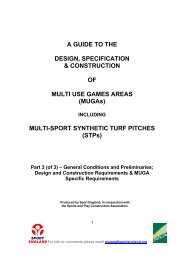View - North East Lincolnshire Council
View - North East Lincolnshire Council
View - North East Lincolnshire Council
Create successful ePaper yourself
Turn your PDF publications into a flip-book with our unique Google optimized e-Paper software.
BOC Immingham Dissolved Acetylene Project Environmental Statement<br />
Target<br />
Note<br />
(TN) No.<br />
TN2<br />
TN3<br />
TN4<br />
TN5<br />
TN6<br />
TN7<br />
TN8<br />
Habitat Description<br />
Middle Drain: a moderate flowing water course, flowing along the northern border of<br />
the application site. The drain is approximately 4 m wide and 0.5 m to approximately<br />
2 m deep. This drain is linked directly to the estuary and is tidally affected.<br />
Common reed (Phragmites australis) is emergent at the bank side and abundant<br />
along the northern bank.<br />
Mammal runs are present throughout the sward and the reeds at the water’s edge,<br />
some of which are large enough to have been made by water vole.<br />
Water vole faeces and a very small amount of water vole feeding signs were<br />
identified (these were reed stems cut into sections around 10 cm long with 45 o cuts<br />
at either end which were hollowed via a split along the stem).<br />
Habitat as for TN2; the habitat changes very little along the northern bank. At this<br />
point a fresh water vole latrine was found.<br />
Hole was found in bank of Middle Drain at water level, size and shape typical of<br />
water vole burrow.<br />
The margins of the arable field, which comprise the bulk of the application site and<br />
immediately surrounding area to the east, are approximately 1 2 m in width and<br />
comprise rough grassland on a shallow earth bank. The field margin mostly<br />
comprises cock’s foot grass (Dactylis glomerata), false oat grass (Arrhenatherum<br />
elatius), dandelion (Taraxacum officinalis), cleavers (Galium aparine) and arable<br />
escapees such as wheat. The target note specifically denotes a pile of dead wood in<br />
this rough grassland area, dead wood can provide habitat for invertebrates and can<br />
also act as sheltering habitat for amphibians and reptiles.<br />
This rough grassland area with the dead wood feature has low potential to support<br />
reptiles for both basking and refuge and low potential to support great crested newts<br />
in their terrestrial phase.<br />
Large pile of dead wood associated with the top of the southern bank of Middle<br />
Drain. Dead wood features near rough grassland or water features are of use as<br />
places of shelter for reptiles and amphibians and for invertebrates.<br />
Former route of Middle Drain and an associated bridge beneath the railway. The<br />
area is now a depression with steep banks of common reed and rosebay willowherb<br />
(Chamerion angustifolium) and scrub including bramble (Rubus fruticosus) and<br />
common hawthorn (Crataegus monogyna).<br />
The area was wet at the time of survey but is expected to dry out very frequently, no<br />
aquatic vegetation was noted. Rainfall had occurred within 48 hours prior to the<br />
survey.<br />
A large area of semi-improved species-poor grassland with tall ruderals (weedy<br />
opportunistic plants often associated with disturbed ground) throughout.<br />
Species within the grassland include red rescue (Festuca rubra), cock’s foot, false<br />
oat grass, curled dock (Rumex crispus), common ragwort (Senecio jacobea) and<br />
common reed. Bulrush (Typha latifolia) occurs in a small localised area within one of<br />
the drains.<br />
The dense unmanaged sward contains anthills and some patches of bramble; along<br />
with the water bodies in the adjacent field to the south and the adjacent railway<br />
ballast, this area is considered to provide excellent habitat for common reptiles and<br />
terrestrial habitat for amphibians.<br />
5100935.404 Environmental Statement August 2011 159




